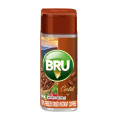 Loading... Please wait...
Loading... Please wait...- Home
- Spices & Blends
- Spices
- Fennel Seeds (Lucknow)14oz-Indian Grocery,Spice,USA
Fennel Seeds (Lucknow)14oz-Indian Grocery,Spice,USA
Product Description
Fennel Seeds (Lucknow). -Small and thin form
Fennel seeds split into two, one sometimes remaining on the stalk. They are 4 -8 mm (1/8 - 5/16 in) long, thin and curved, with colour varying from brown to light green (the green being superior).
Bouquet: warm, sweet and aromatic. Flavour: similar to a mild anise.
The major constituents of Fennel, which include the terpenoid anethole, are found in the volatile oil. Anethole and other terpenoids inhibit spasms in smooth muscles, such as those in the intestinal tract, and this is thought to contribute to fennel’s use as a carminative (gas-relieving and gastrointestinal tract cramp-relieving agent).
Related compounds to anethole may have mild estrogenic actions, although this has not been proven in humans.
Fennel is also thought to possess diuretic (increase in urine production), choleretic (increase in production of bile), pain-reducing, fever-reducing, and anti-microbial actions.
The Fennel seeds are used as a flavoring agent in many herbal medicines, and to help disperse flatulence. The seeds, and roots, also help to open obstructions of the liver, spleen & gall bladder, and to ease painful swellings, in addition to helping with yellow jaundice, the gout and occasional cramps.
.









